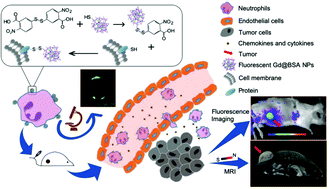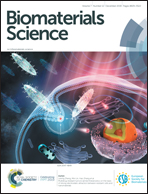A highly sensitive living probe derived from nanoparticle-remodeled neutrophils for precision tumor imaging diagnosis†
Abstract
Timely and precise diagnosis of malignant tumors is of great value to patients’ treatment and prognosis. Although nanotechnology-based molecular imaging represents a major advancement in the field of tumor imaging diagnosis, it is restricted by the rapid blood clearance of nanoparticles and the diverse physiological barriers in vivo; hence, its further application is greatly hindered. Cell carriers, ascribed to their natural biological properties, are thus gaining increasing attention for addressing such issues. Here, taking full advantage of the inflammation-homing capability of neutrophils, we constructed a highly sensitive cell probe in which reduced bovine-serum albumin (BSA) nanoparticles, loaded with imaging agents (gadolinium (Gd) and BODIPY), were covalently fixed onto the cellular surface by 5-thio-2-nitrobenzoate (TNB)-mediated fast and efficient disulfide–thiol exchange. Impressively, the remodeling process exerted a negligible effect on the neutrophils’ biological profiles with regard to cell viability, morphology, and cell-surface protein markers. Compared with nanoparticle-based imaging agents in a lung-cancer xenograft model, the living neutrophil probe demonstrated faster targeting and stronger accumulation in the tumor site, as revealed by fluorescence and magnetic-resonance (MR) imaging. These results indicate the great potential of neutrophil-based living probe for precision tumor-diagnosis applications.



 Please wait while we load your content...
Please wait while we load your content...